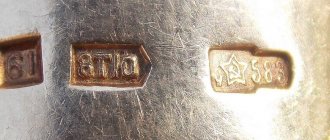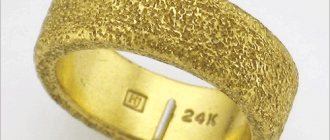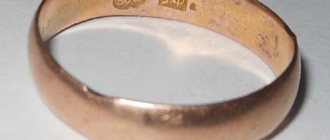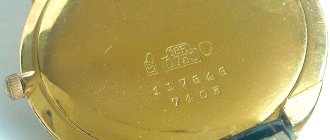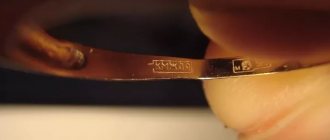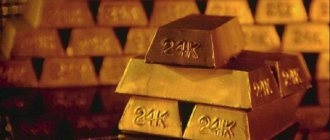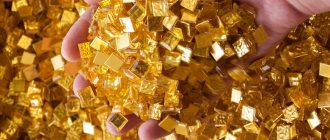What affects the price
The global gold market is forced to live by certain rules. Thus, the value of an asset today is mainly influenced by speculative activity, rather than real supply and demand.
They have repeatedly tried to link the dynamics with the volume of production, but this has never been possible, since, unlike oil, there cannot be a big dependence here.
Thus, the only more or less significant factor is the seasonal increase in demand. Outbursts usually occur in summer or spring. It is during these periods that mass weddings take place in Asian countries, and this region generally traditionally leads in gold consumption.
It is much easier to see the pattern of fluctuations in the exchange rate of a precious metal if you compare its quotation with the situation developing at a particular moment in the foreign exchange market. So, the more uncertainty and chaos there is in the latter, the more expensive gold is sold.
The increase in the cost of a gram today, for example, can easily be explained by the depreciation of the dollar. The American currency looks less and less attractive in the eyes of investors, and therefore they prefer to invest in gold.
As a result, in the last year alone the metal has become more expensive by 5 percent. The change in exchange rate led to an increase in prices for jewelry.
Simple substance
In 1869, D.I. Mendeleev formulated the periodic law, which establishes the relationship between atomic weight and the properties of a chemical element. According to the classification proposed by the Russian scientist, gold occupies 79th position. The noble yellow metal is a simple substance because it consists of atoms with the same electrical charge of the nucleus.
In Russian, the word “gold” comes from the Old Slavonic “zlato”, one of the translations of which defines the category “yellow color”. The first letters of the Latin morpheme aurum give the symbol for the periodic table element Au.
Properties of gold
Gold belongs to the group of heavy metals. Its density is 19.32 g/cm³. If a soccer ball with a diameter of 30 cm is cast from pure gold, then such a sports equipment will weigh 272.992 kg. The heaviest metal on the planet is osmium, whose density is 22.61 g/cm³.
Gold begins to melt at a temperature of 1064˚ C. Boiling occurs when it reaches 2856˚ C. Having overcome the melting point, the metal intensively evaporates and the density decreases. The chemical element conducts heat and electric current well.
The plastic material has a hardness on the Mohs scale of about 2.5 units, which is comparable to the strength of a nail. The softness of the substance makes it possible to obtain sheets one micron thick , which are called “gold leaf”. In thin products, a blue-green tint is added to the yellow color of the metal.
Chemists classify Aurum as inert substances that do not interact well with alkalis and acids. Gold dissolves in saturated chlorine water, mercury or a concentrated mixture of hydrochloric and nitric acids taken in a 3:1 ratio. At temperatures above 300˚ C, the precious metal reacts with fluorine. Gold items react with liquid bromine and potassium iodide solution.
Precious metal mining
The main gold reserves are concentrated in granite rocks and deposits with complex minerals, which are called placers. The physical and chemical properties of the Au element are used in extracting the precious metal from rocks.
At the initial stage, the ore is washed. Due to its high density, gold is collected in the enriched fraction of the rock. The process of purifying the substrate takes place in special installations - dredges. In addition to the precious mineral, the resulting concentrate contains associated heavy minerals.
The second stage of cleansing takes advantage of Aurum's ability to interact with mercury and zinc. The moistened concentrate is mixed with these metals. In the first case, an amalgam is obtained, in the second case, cyanides are formed. Then, by distilling the mercury mixture or treating the zinc dust using simple chemical reactions, a pure product is obtained. A prerequisite for the process is the presence of oxygen.
The top five countries producing gold raw materials include:
- People's Republic of China.
- Australia.
- Russian Federation.
- USA.
- Canada.
Areas of use
From time immemorial, money has been minted from yellow metal. For a long time, valuable coins remained a means of payment when carrying out trade transactions. Over time, paper banknotes became the equivalent of “despicable metal”, and ancient coins passed into the collections of numismatists.
Gold is a traditional material for creating jewelry. In combination with silver and copper, alloys of various grades are obtained. The metal is used to make state awards, sports prizes, jewelry, cutlery and dishes.
Gold and foreign exchange reserves are considered an important component of the state financial system. Gold reserves in developed industrial countries reach 20% of the total amount of external assets. The precious metal is a source of liquidity for central banks.
In industry, gilding of surfaces that are exposed to the environment during operation is common. Microcircuits use contacts and printed circuit board elements made of precious metal. Gold plates are used as targets in scientific studies of the atomic nucleus.
In cooking, tinsel is used to wrap expensive sweets. In dentistry, dentures and crowns are made from alloys of gold with other substances. Pharmacists introduce compounds of this metal into medications used in the treatment of tuberculosis. The Au₁₉₈ isotope is used in the irradiation of oncological tumors.
Dynamics
The price of a kilogram of precious metal largely depends on the demand for it. The latter is growing continuously. Ordinary people are buying more jewelry, industry needs pure metal, and investors are looking for opportunities to make extra money on the positive dynamics.
The instability of the global economy, inflation in developing countries, and the deficit of their balance of payments - all this increases the demand for gold. The trends are reinforced by the periodic outbreak of armed conflicts.
For example, in the last years of the 70s, a kilogram of metal cost $850. But later prices crawled down, and the trend continued in this form until the end of the century. America is to blame for this. The link to oil ensured the strengthening of its currency and Treasury securities. As a result, it became more profitable to invest in them, and the hype around gold subsided. Because of this, many countries began to gradually get rid of traditional reserves, replacing them with US bonds. For example, now Canada does not have a ton of gold left.
The history of the appearance of gold in bars
Gold has been used as a means of payment since ancient times. But then a difficulty arose when paying - it was necessary to weigh each time and determine the quality of the valuable metal. This made transactions difficult.
Approximately 600 BC. e. The ancient Indians began to use a new method - they smelted an alloy of silver and gold, today it is called electrum.
The precious metal had a certain value and weight, which had to be indicated on the product (a state mark was placed). This made it possible to solve the problem, which was the need for constant monitoring of the quality of gold in the absence of extensive opportunities.
How much does a kilogram cost now in the Central Bank of the Russian Federation?
According to the exchange rate of the Central Bank of Russia, the cost of 1 kilogram of gold is 3,094,900 rubles.
Accordingly, a gram will cost 3,094.9. For comparison, in 2022 they asked for only 2,200 for the same volume. It is not difficult to calculate how much you could earn from a successfully purchased kilogram. It will come out to almost 800,000 rubles - and this is in just 3 years!
On the world market, assets are sold not in kilograms, but in troy ounces. Now the price of one has reached 1,556.25 in dollars, and in rubles it will be 96,440.81. Accordingly, per gram comes out to 50.03 and 3,100.36.
The largest and different from the standards
Until 2005, the world record was claimed by an ingot smelted in Taiwan, weighing 220 kg.
Photo: 220 kg block
But its size inspired the Japanese holding Mitsubishi Materials. Not wanting to be left behind, his specialists cast another one, surpassing the record holder by 30 kg. Made in the shape of an isosceles trapezoid, with dimensions of 455x225x170 cm. Today it is the largest. The Guinness Book of Records certificate only confirms its uniqueness.
Photo: world's largest Japanese ingot
No less interesting are the hand-made non-standard gold bricks. For example, Chip Gold bars are designed like a bank card and weigh 1–20 g.
Interesting fact! In the Emirates, at the Emirates Palace hotel you can purchase 10-gram bars through a goldsmith. The German-made machine is capable of tracking current prices and dispenses the precious product after paying the appropriate amount at the time of purchase.
Photo: Zolomat
Sometimes pieces of native metals of remarkable weight are found in nature. And although experts have not yet come to a consensus on what kind of find can be called a nugget, the largest in the world is unanimously recognized as the one found 145 years ago in Australia in 1872. Although in fact it was a slab weighing 235.5 kg, named after named after the discoverer, "Holtermann Plate". It contained more than 93 kg of gold.
The real nugget was “The Welcome Stranger” (1869), also from the fifth continent, weighing 70.9 kg.
In the same Australia, a sunstone called “Brilliant Barkley” was found in 1857. Its weight exceeded 54 kg.
Later, in 1901, the find was announced in Japan. The nugget weighing 71 kg was the only one discovered in this country.
It's sad that the most famous of them didn't survive. They were sold, weighed, measured and melted into bars or coins. The only one that “survived” was the “Big Triangle” - a 36-kilogram piece of gold, which was found in the Southern Urals in the Miass region in 1842, today it is stored in the Diamond Fund of the Russian Federation.
Photo: “Big Triangle”
The material from which the ingots with a printed hallmark of 999.9 are made can be considered a reference material. It is the purest of all products available to modern investors. And it will continue to be used by relevant government agencies, such as the central banks of various states, to replenish storage facilities and form funds.
Author: Demidova Marina. April 4, 2022.
Banks
Financial institutions make money from the purchase and sale of various assets, and the one discussed in this article is no exception.
How many kilograms of pure gold (999 purity) costs here? It all depends on the current policy and also on whether you want to get rid of the metal or, on the contrary, acquire it.
For example, the price of one gram in Sberbank is 2,926 when buying, 3,229 when selling. Accordingly, a kilogram will cost 2,926,000 and 3,229,000.
When investing in gold, you should take into account that the cost of real metal is always higher, because it also includes the costs of production, transportation, and finally VAT.
The most favorable rates for purchasing bullion in Russia
Sber updates precious metals quotes on its website on weekdays. It looks like this:
Bank Alfa does the same:
As you can see, it is better to purchase metal in Alfa and sell in Sberbank.
But the indicated prices do not mean that the gold bar in the bank will be sold at the price determined in the table; VAT and commission will also be added to these figures.
For example, quotes for precious metals at Gazprombank:
The cost of bars at Gazprombank on the same date:


